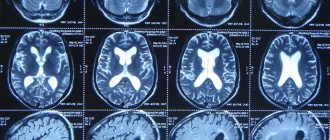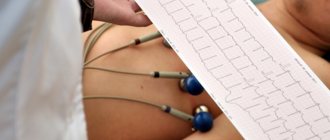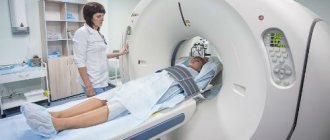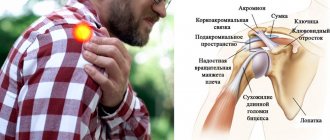Co-author, editor and medical expert - Dmitry Dmitrievich Volosov.
Number of views: 171 829
Last updated date: 12/20/2021
Average reading time: 3 minutes
Headache with blood pressure disorders Treatment of headaches with blood pressure disorders Motrin® in the treatment of headaches
Headache with high blood pressure is one of the most common symptoms. It indicates a number of health problems that require seeing a doctor and receiving appropriate treatment. Depending on what exactly causes the headache, its characteristics may vary.
Headache due to blood pressure disorders
Pressure headaches vary according to the following symptoms:
- Headache due to hypertension is often described as squeezing and dull, which feels like a hoop squeezing the head. During physical exertion, stress, and coughing, it can become pulsating, radiating to the ears and eyes. Most often, a person experiences pain in the back of the head and temporal region. Hypertensive pain is often accompanied by nausea and episodes of disorientation;
- Headache with normal blood pressure deserves special attention. Most often, this is tension pain, which can imitate problems with blood pressure (throbbing, pressing or bursting pain in the temples and back of the head), but it is caused by overstrain of the neck muscles and vascular spasms. Therefore, the only reliable indication of the reasons for which pain developed is the tonometer readings and a medical examination.
Up to contents
Welcome to the website of the State Health Institution “City Clinic No. 5”!
Details Published 08/19/2020 07:15 Why blood pressure drops: seven possible causes of hypotension
Low blood pressure is often a symptom of cardiac failure, when the heart pumps blood worse and vascular tone is weakened
Is it normal for it to increase with age? Experts talk about the real causes of blood pressure problems.
Hypotension (scientifically called arterial hypotension) is a condition when, when measuring pressure, the tonometer shows numbers below 105/70 mm Hg. Art. As a rule, it is accompanied by weakness, dizziness, headaches, and nausea.
1. There are people who have LOW BLOOD PRESSURE as an innate feature of the autonomic nervous system. These are people of the so-called asthenic type (as a rule, they have a fragile physique, light or brown hair, pale skin), they make up about 7% of the population. They are not distinguished by great endurance and performance, but they live quite active lives and do not feel
your low blood pressure. But an increase in pressure even to the normal limits (120/80) is tolerated very poorly.
2. Low blood pressure is often a symptom of cardiac failure, when the heart pumps blood worse and vascular tone is weakened. Often this condition occurs against the background of inflammatory heart diseases - endo- and myocarditis, which in half of the cases develop as complications after tonsillitis and flu. Hypotension also accompanies diseases associated with impaired nervous regulation of the heart (various arrhythmias and blockades). All these disorders are clearly visible on the ECG.
3. Vegetative-vascular dystonia of the hypotonic type (scientifically called neuro-circulatory dystonia). Because there are two types of reactions in this condition: sympathoadrenal and parasympathetic
Psychiatrists joke that a person’s soul is not in the heart, but in the kidneys - after all, stress hormones are produced in the adrenal glands:
- Adrenaline (“aggressive hormone”) excites, causes a feeling of heat, a rush of blood to the head, increased blood pressure, sweating, aggressive irritability, dysphoria (an irritable-sullen mood).
- Acetylcholine (“weakness hormone”), on the contrary, lowers blood pressure, causes cold sweats, chills, irritable weakness, a feeling of melancholy and weakness.
— And some people have mixed attacks, when acetylcholine and adrenaline reactions alternate. This gives rise to pressure surges, a person literally throws himself into the heat, then into the cold, says psychiatrist, psychotherapist, psychosomatics specialist Anatoly German.
4.LOCKED PRESSURE can be a side effect of some medications. The pressure can be “dropped” by:
- heart medications (nitroglycerin preparations, beta-blockers),
- large doses of antibiotics,
- antispasmodics and painkillers,
- large doses of “simple” sedatives (Corvalol, Valocordin, tinctures of peony and motherwort). Valerian has a milder effect.
5. A sudden drop in pressure occurs during an exacerbation of a stomach ulcer or an attack of pancreatitis. Usually this condition, in addition to pain in the stomach, is accompanied by general weakness and cold sweat. This is symptomatic hypotension and will go away once you heal your stomach.
Also, pressure always drops with any bleeding: nasal bleeding, hemorrhoidal bleeding.
6. Hypotension almost always accompanies some types of depression:
- asthenic - depression of exhaustion. With it, a feeling of fatigue prevails, outwardly there is a hint of exhaustion, a person can even seriously lose weight.
- apathetic. She is characterized by complete indifference to her surroundings, she doesn’t want anything, “nothing pleases, nothing hurts...”
- anhedonic. This is a loss of joy. Saturation with emotions, a feeling of mental impasse. Depression of great emperors and successful businessmen.
7. In completely healthy people, pressure can drop sharply after procedures that cause vasodilation - Russian baths, saunas, thermal baths, body wraps. So everyone, and especially older people, need to monitor their blood pressure very carefully if you go to the sauna. You should not stay in the steam room for more than 5-7 minutes at a time. Even if you are a fan of bath procedures, you need to take breaks and under no circumstances drink alcohol either before or after the bath.
Treatment of headaches due to blood pressure disorders
To achieve lasting results and get rid of headaches, it is necessary to eliminate its source - blood pressure disorders. This condition can develop for many reasons, so treatment requires a preliminary examination and only then a course of therapy. There is no need to self-medicate and self-diagnose, or ignore headaches. This is fraught with serious consequences. In parallel with following the doctor’s orders, you can take independent actions that will help relieve pain and/or reduce the frequency of its attacks:
- control over sufficient rest;
- correction of the diet towards a healthy diet (with the exception of everything that negatively affects the cardiovascular system - alcohol, strong coffee, smoking, high-fat foods, etc.);
- maintaining physical activity at a healthy level (absence of excessive and/or unwanted stress, avoiding a sedentary lifestyle, massage (if there are no prohibitions), self-massage of the cervical spine);
- long walks in the fresh air;
- eliminating circumstances that provoke stress or an emotionally unhealthy environment.
Up to contents
Hypotension with VSD: how to treat nausea and dizziness in the morning
Dizziness and nausea with vegetative-vascular dystonia are associated with a sharp decrease in blood pressure. This is explained by the inadequate regulation of peripheral vascular tone, as well as venous insufficiency, which often accompanies VSD. It is difficult for a person with low blood pressure to maintain vigor and good health during the day; he has a particularly difficult time with hunger and thirst, is irritable, and inattentive. It takes a lot of effort for a hypotensive person to wake up in the morning and get out of bed. Our recommendations will help facilitate this process and improve your overall condition.
- Morning coffee is the most popular way to slightly increase blood pressure during hypotension. For people with VSD with frequent dizziness and weakness, doctors recommend two to three cups of coffee a day. If you don't have access to coffee, take one caffeine tablet. For arrhythmias and heart failure, which can also be accompanied by low blood pressure, coffee and products containing caffeine are contraindicated.
- Pouring your feet with cold water. You can tone up with a cold shower below your knees. A cold shower in your legs will help your veins contract and return more blood to your upper body, meaning you won't feel dizzy from low blood pressure. It's a pity that this simple method cannot help maintain normal blood pressure all day long. To reduce the likelihood of dizziness during the day with dystonia, regular cool foot baths in the morning and before bedtime are recommended.
- Gymnastics in bed. If morning exercises make you want to lie down as soon as possible, then exercises while lying in bed are what you need. Orthostatic collapse with VSD most often occurs immediately after waking up, when a person tries to jump up at the alarm clock. Several exercises in a lying position will activate blood circulation and restore muscle tone to the vessels of the legs. No tricks: lying on your back, stretch your arms and legs in opposite directions as hard as you can, rotate your feet, do the “bicycle” exercise for 30 seconds, roll over onto your stomach and bend your back, clasp your ankles with your hands and rock back and forth for 30 seconds, stretch forward first one hand, then the other. After this, sit on the bed and stay in this position for about a minute.
- Freshly squeezed orange juice immediately after waking up. This method is suitable if you have normal or reduced acidity of gastric juice. For frequent heartburn and stomach pain, drink 150-200 ml of water with a squeeze of lemon. This way you will immediately replenish your blood volume and it will be easier to keep your blood pressure at an acceptable level. Vitamin C from an orange (in smaller quantities from a lemon slice) activates the sympathoadrenal system, and the second mechanism of increasing blood pressure will work.
An increase in the level of glutathione in the body, a strong endogenous antioxidant, the deficiency of which is associated with the development of vegetative-vascular dystonia. You can activate the synthesis of glutathione by taking amino acids, from which it is formed as a result of a biochemical reaction inside cells: glutamic acid, cystine, glycine. The drug Eltacin® contains three essential amino acids in an optimal ratio and is recommended as the main medicine for dystonia.
Motrin® for the treatment of headaches
Motrin® belongs to the group of non-steroidal anti-inflammatory drugs and provides a pronounced analgesic effect for headaches of various types and origins. This drug allows you to maintain the pain-relieving effect with just two doses per day: one tablet eliminates pain for 12 hours. The drug is intended for the symptomatic treatment of pain in adults and children over 15 years of age. Before using Motrin®, you should read the instructions for the drug and consult your doctor.
Up to contents
The information in this article is for reference only and does not replace professional advice from a doctor. To make a diagnosis and prescribe treatment, consult a qualified specialist.
Pain at the base of the skull
Rheumatism
Arthritis
32672 11 February
IMPORTANT!
The information in this section cannot be used for self-diagnosis and self-treatment.
In case of pain or other exacerbation of the disease, diagnostic tests should be prescribed only by the attending physician. To make a diagnosis and properly prescribe treatment, you should contact your doctor. Pain at the base of the skull: causes of occurrence, what diseases it occurs with, diagnosis and treatment methods.
Definition
Pain at the base of the skull (vertebrogenic cervicocranialgia) is a pain syndrome localized in the cervico-occipital region, which can spread to the frontotemporal region and the eye area on the homolateral side. It has been proven that the source of pain can be the structures of the upper cervical spine. Typically, this is the level of the C1, C2 and C3 vertebrae, which includes joints, discs, ligaments and muscles. The lower cervical vertebrae, as a rule, play an indirect role in the formation of clinical symptoms of pain.
Pathological diseases of the cervical spine, which are accompanied by intense or aching pain, experts call “painful neck” syndrome.
The International Headache Society, 3rd revision (ICHD-3) recommended considering cervicogenic headache as secondary, arising due to changes in the cervical spine, including bone structures, intervertebral discs, and soft tissue structures, the pathology of which is often accompanied by pain in the cervical spine. neck. 70% of patients with pain in the cervical spine simultaneously experience headache, but only in 18% of cases is it considered a consequence of neck pain.
In the genesis of headaches in childhood and adolescence, functional disorders in the spinal motion segments of the cervical spine, in particular disorders in the structures of its upper cervical spine, play a significant role.
Types of pain at the base of the skull
Cervicogenic pain is indicated by differential features such as unilateral headache extending from the back of the head to the front, and evidence of involvement of the cervical spine. An attack of pain can be triggered by applying pressure to trigger points in the neck/occipital area or holding the neck in an awkward position. It is important that in some cases such pain has migraine-like features - a number of patients experience photo- and phonophobia, lacrimation, nausea, vomiting, which can sometimes be regarded as a manifestation of migraine.
Pain at the base of the skull is characterized by limited range of motion in the cervical spine, soreness of the neck muscles, changes in muscle tone, or a reaction to passive or active stretching. Usually the pain is combined with a functional block at the upper cervical level.
Injuries to the upper cervical spine due to tumors, fractures, infections, and rheumatoid arthritis can cause headaches that present clinically in the same way as cervicocranialgia. However, a feature of cervicogenic headache is that it is provoked by movements in the cervical spine, and after performing certain warm-up movements in the neck it can stop. Most often, such complaints are not associated with serious pathology, and the patient makes a full recovery.
Possible causes of pain at the base of the skull
Pain at the base of the skull is based on functional and organic changes in various anatomical structures of the cervical spine: joints, ligaments, fascia, muscles, nerves. The leading role is given to degenerative-dystrophic changes in the spine. However, there are only isolated indications of the role of functional disorders.
One of the main causes of neck pain is staying in a fixed position for a long time. Other causes of the disease include:
- osteochondrosis, spondyloarthrosis, spondylosis, uncovertebral arthrosis and other changes in the spine;
- neck injuries, injuries;
- sprains;
- intervertebral disc herniation;
- spondyloarthritis, rheumatoid arthritis.
A common cause of cervicogenic pain is inferior oblique muscle syndrome.
A spasmed muscle can compress the neurovascular bundle passing under it (segment of the vertebral artery with the periarterial sympathetic plexus, occipital nerves) - for this condition, the development of paresthesia in the scalp is typical, and sometimes there is pain when combing the hair. It has been observed that stimulation of the cervical structures causes pain, and anesthesia reduces it. Lately, doctors are increasingly talking about “text neck” syndrome, which develops in people who spend a lot of time reading texts from electronic devices (gadgets).
The head of an adult weighs about 5 kg - this is the weight the neck experiences in its normal position. When reading from gadget screens, the head is usually tilted: when tilted just 15°, the load on the spine increases to 12 kg, and when tilted 60° – up to 27 kg. As a result, posture changes, the intervertebral discs of the cervical spine suffer, muscles spasm, and pain occurs at the base of the skull.
The main manifestations of pain at the base of the skull include:
- frequent contraction of the neck muscles, convulsions;
- painful sensations when turning the head;
- noise in the head, sleep disturbance;
- pain in the cervical spine, radiating to the head;
- dizziness;
- constant tension in the neck and back of the head.
The presence of three to four signs should make the patient think about seeking medical help.
Which doctors should you contact if you experience pain at the base of the skull?
To determine the cause of the headache, you should contact a general practitioner or. The doctor will prescribe the necessary examination, determine the cause of the disease and prescribe treatment.
Diagnosis and examinations for pain at the base of the skull
The following diagnostic criteria are used to make a diagnosis:
- The causal relationship of headache with pathology of the cervical region is based on at least one of the following signs:
- clinical signs confirm that the source of pain is located in the neck;
- pain stops after diagnostic blockade of neck structures or nerve formations (with an adequate comparative study with placebo).
Using clinical, laboratory and/or neuroimaging methods, signs of disorder or damage in the cervical spine or soft tissues of the neck that are a reliable or possible cause of headache are determined:
- X-ray of the cervical region in several projections;
Diagnosis of headaches due to hypotension
It is important to determine the exact reason why your blood pressure drops and your headache occurs. It is not difficult to measure this indicator, including at home. It is enough to use a tonometer and determine that the pressure has been reduced to 90/60 mm. rt. Art. and less. However, doctors at the Clinical Brain Institute recommend undergoing a full examination if hypotension occurs frequently and is accompanied by headaches. To determine the cause of this disease, additional techniques may be required:
- general and biochemical blood tests, as well as determination of the rate of blood clotting;
- Dopplerography - ultrasound of blood vessels with the addition of a contrast agent, informative for diagnosing blood flow in the neck and head;
- MRI of the cervical spine - allows you to determine osteochondrosis, intervertebral hernias and other pathologies that impair blood circulation;
- electrocardiography, ultrasound of the heart - prescribed for suspected heart failure and other diseases.
At the Clinical Brain Institute, you can undergo comprehensive diagnostics, which will help determine the cause of chronic hypotension. Our main advantages are the availability of precise and modern equipment, high qualifications and many years of experience of our specialists. After examination and diagnosis, the doctor will select a treatment regimen to relieve attacks of hypotension and reduce the manifestation of headaches.
What to do?
At Dr. Shishonin’s clinic, specialists very often encounter cases where the patient complains of a headache that does not disappear after the pressure is reduced. Then an ultrasound examination is required to find out the condition of the vessels of the skull.
The doctor says:
Dr. Shishonin draws the attention of patients to the fact that almost every second case of headache with which they come to him is associated with a violation of the venous outflow.
If you relieve pressure through correction, that is, without medications, normalizing venous outflow and arterial inflow naturally, as happens in Dr. Shishonin’s clinic, then this problem does not arise. With a natural decrease in pressure, when blood circulates freely, the head will not hurt, which means the blood vessels will be in order.
Advice:
Gymnastics for the neck, which Alexander Yuryevich recommends to all his patients, will help reduce blood pressure naturally and normalize the outflow and inflow of blood without the use of drugs that poison the liver.
This problem can only happen if you reduce your blood pressure with medication. The pills affect the heart, causing it to work less forcefully, and intracranial pressure remains at the same level. As a result, the tonometer will show that your blood pressure is normal, but your head will hurt. What to do in this case? This situation means that the neck and its vessels are affected, and the neck needs to be treated. Check out other videos on the “Club of Former Hypertensive Patients” channel and find out how you can use gymnastics to get rid of vascular problems, improve the health of the cervical spine and get rid of pain forever. Be healthy!
Why does my head hurt?
If the venous outflow is disrupted, that is, the veins are pinched, you take pills, the heart stops pumping blood in large quantities, but it cannot descend back from the brain in full, which means the headache does not disappear. In this case, you should definitely consult a doctor and check the condition of the blood vessels, since excessive accumulation of blood in the brain is very dangerous.
Important:
If the venous outflow is impaired, the pressure in the body system drops, but the intracranial pressure remains high, which provokes a headache.
This is the main reason why, when taking medications, the headache may not go away, but remain the same, and it does not matter how sharply the pressure drops. In this case, do not panic and take other pills that have pain-relieving properties. After some time, the pain will go away, and neck exercises will help speed up this process. They normalize blood flow and help veins cope better with their function.








